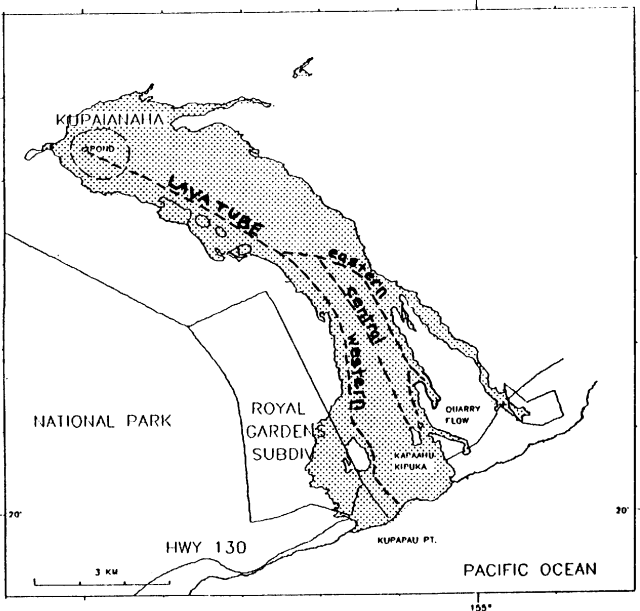Report on Kilauea (United States) — April 1989
Scientific Event Alert Network Bulletin, vol. 14, no. 4 (April 1989)
Managing Editor: Lindsay McClelland.
Kilauea (United States) Lava flows threaten houses
Please cite this report as:
Global Volcanism Program, 1989. Report on Kilauea (United States) (McClelland, L., ed.). Scientific Event Alert Network Bulletin, 14:4. Smithsonian Institution. https://doi.org/10.5479/si.GVP.SEAN198904-332010
Kilauea
United States
19.421°N, 155.287°W; summit elev. 1222 m
All times are local (unless otherwise noted)
Kīlauea's . . . eruption continued to feed lava through tubes into the ocean near Kupapau Point during April. Surface lava breakouts along the W tube were active 1-12 April and extended from ~300 m (top of the fault scarp) to 70 m altitude. Lava traveled along the W side of the flow field, entering the E margin of the Royal Gardens subdivision (figure 60). A major breakout on the 13th at ~500 m elevation remained active throughout the month. Large surface flows burned forest to the W and on 25 April passed within 50 m of an occupied home . . . . Access to the upper subdivision, as well as several houses, were threatened. By the end of the month, the flow had reached 60 m elevation and slowed, but was still active. Surface activity from the E tube at the top of the fault scarp was sporadic in early April but ceased after the 10th. The terminus of a breakout from the central tube was active just above the Kapaahu kipuka but stagnated after the 12th. The lava breakouts from the W tube on the 13th apparently lowered the magma supply to the E and central tubes, causing their flows to stagnate. The active portion of the seacoast bench that had formed since the 23 March collapse measured 160 x 60 m at the beginning of the month. Following two large collapses on 13 April (at 2024) and 22 April (at 2307), the bench continued to rebuild.
The lava pond at Kupaianaha was 20-25 m below the rim during April. Lava was observed in the crater bottom of Pu`u `O`o . . . for most of the month, ranging from spatter to a sizeable lava pond that covered much of the crater floor. Gas pistoning events were witnessed at mid-month. By the 25th, only glowing holes in the rubble at the crater bottom could be seen.
Most of April's 18 strongly recorded seismic events . . . were tightly clustered beneath Kīlauea's summit and S flank. Shallow events (0-5 km depth) continued to be recorded. The number of intermediate-depth long-period events beneath the summit decreased and developed a fluctuating pattern after a persistent high rate in March. Increasingly longer bursts of deep tremor (40-60 km depth), at near-regular time intervals during the first half of the month decreased thereafter. Low-level tremor continued beneath Pu`u `O`o and Kupaianaha. Relatively steady tremor amplitude beneath Pu`u `O`o was interrupted 13-17 April by short gas piston bursts and long intervals of banded tremor, correlated with increased activity in the crater. Tremor returned to a relatively steady state in the latter part of the month. Low-amplitude signals from lava entering the sea near Kupapau Point continued to be recorded.
Geological Summary. Kilauea overlaps the E flank of the massive Mauna Loa shield volcano in the island of Hawaii. Eruptions are prominent in Polynesian legends; written documentation since 1820 records frequent summit and flank lava flow eruptions interspersed with periods of long-term lava lake activity at Halemaumau crater in the summit caldera until 1924. The 3 x 5 km caldera was formed in several stages about 1,500 years ago and during the 18th century; eruptions have also originated from the lengthy East and Southwest rift zones, which extend to the ocean in both directions. About 90% of the surface of the basaltic shield volcano is formed of lava flows less than about 1,100 years old; 70% of the surface is younger than 600 years. The long-term eruption from the East rift zone between 1983 and 2018 produced lava flows covering more than 100 km2, destroyed hundreds of houses, and added new coastline.
Information Contacts: C. Heliker and R. Koyanagi, HVO.


